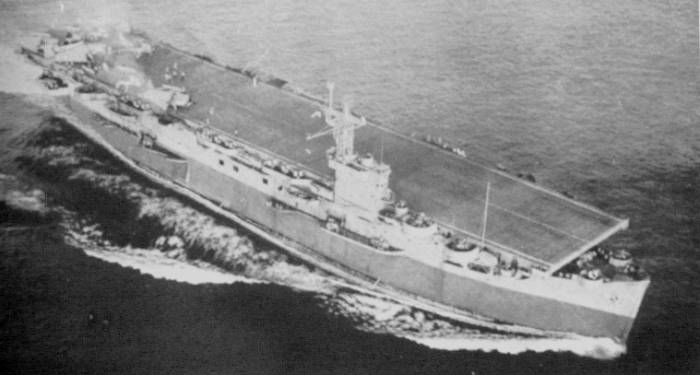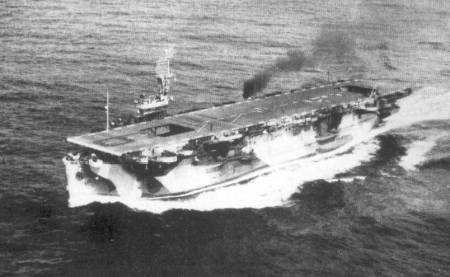

Early British combat experience indicated that at least a small island would be required by that ship, and in all later ships, a small island was indeed fitted.
The Tracker design became the basis and prototype for the American Bogue class, of which a total of eleven were commissioned in the U.S. Navy, and of which the majority, especially of those ships ordered for Financial Year 43, were transfered to the Royal Navy.
The major factor in the C-3 merchant ship conversions, building on hulls that could be quickly fabricated and establishing only the most necessary aviation facilities, was speed and ease of construction.
In that, the design admirably succeeded, but several design flaws marred that fine premise. The crude installation of the aft elevator made aircraft handling difficult; the ships had only one screw, a distinct
disadvantage in handling damage; and they were not optimally suited for aircraft handling even with their larger hangars, which followed the sheer and camber of the original merchant ship deck.

The original battery for this class specified 2 5” L/51 guns, plus four quadruple 1,1” guns, which would be comparatively easy to come by since they were being removed from front-line warships.
Modification History
All ships had their initial outfit of 5” L/51 guns replaced by L/38 guns in due course, later ships were completed with them. The ultimate anti-aircraft batteries comprised sixteen 40mm L/56 and twenty
20mm L/70. Not all ships were thus fitted. Radar equipment was added according to the time and location of the ship, but in general, SC air-search radar comprised the most modern radar suite, combined
with high-frequency / direction-finding antennae. In mid-1945, modernizations comprising the use of modern fire-direction equipment and additional 40mm guns were contemplated, but not universally applied.
Service
Service records varied greatly with the theater served in; Bogue, Card, Core, Block Island and Croatan operated in the Atlantic on ASW duty (on which
Block Island was lost), joining the Pacific Fleet only in the summer of 1945 (Croatan did not do so). Copahee, Altamaha, Barnes and Breton operated as a convoy
escort and aircraft transport in the Pacific. Nassau conducted amphibious support operations in the Pacific. Prince William was a training carrier in the Atlantic.
Ships in class:
CVE-9 Bogue
CVE-11 Card
CVE-12 Copahee
CVE-13 Core
CVE-16 Nassau
CVE-18 Altamaha
CVE-20 Barnes
CVE-21 Block Island
CVE-23 Breton
CVE-25 Croatan
CVE-31 Prince William
|
|
Displacements:
Standard: ~8500 tons Full: 14,914 tons Length: 151,8m / 495ft 8" Beam (Waterline): 21,18m / 69ft 6" Draft (Full Load): 7,26m / 24ft 8 3/4" Height: ???? / ???? Crew (Officers/Men): 100/808 Endurance: 26.300 at 15 knots Speed: 16.5 knots |
|
|
Belt: No belt armor
Deck: No deck armor Barbettes: No barbette armor Conning Tower: No conning tower armor |
|
|
(As designed):
Main: 2 x 127mm L/55 on the stern Secondary: None AA: 16 x 28mm L/74 in quad mounts, plus a number of 20mm L/70. Aviation: ~24 planes |